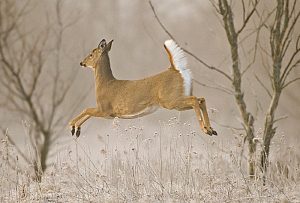State agencies remind motorists to resist the urge to swerve to avoid deer
October 20, 2022 Fall is here and the Illinois Department of Transportation and Illinois Department of Natural Resources are each reminding motorists that deer mating season has also arrived. That means deer become more active, mainly at dawn and dusk from October through December.
Fall is here and the Illinois Department of Transportation and Illinois Department of Natural Resources are each reminding motorists that deer mating season has also arrived. That means deer become more active, mainly at dawn and dusk from October through December.
“Deer often travel in groups, so if a deer crosses the road ahead of you, there is a good possibility that another will follow. Always be prepared for the unexpected. A deer might stop in the middle of the road or double back,” said Illinois Transportation Secretary Omer Osman. “Don’t veer for deer — it could cause you to lose control of your vehicle and swerve into another lane or off the road.”
In 2021, 14,522 motor vehicle crashes involved deer in Illinois. Of these, 13,936 resulted in damage to property or vehicles, while 584 caused personal injuries. Two of the crashes resulted in fatalities.
Although a collision with a deer can happen any time, we are entering the peak season for crashes with them. Last year, more than 42 percent of crashes involving deer in Illinois occurred in October, November and December, with November being the highest-risk month. Rural environments were the site of more than 72 percent of all motor vehicle crashes involving deer, with more than 71 percent occurring at twilight or nighttime.
Safe driving tips for deer mating season:
- Be aware of your surroundings, especially in areas with deer crossing signs.
- Scan the sides of the road for eye shine – the reflection of headlights in their eyes.
- Slow down if you see a deer. They travel in groups, so more are likely nearby.
- Prepare for the unexpected. Deer may stop in the middle of the road.
- If a collision is inevitable, don’t veer. Try to glance your vehicle off the deer and avoid swerving into the opposite lanes of traffic or off the road.
Deer can appear suddenly in surprising environments, so be on alert, slow down and pay attention in areas where they are known to travel.







